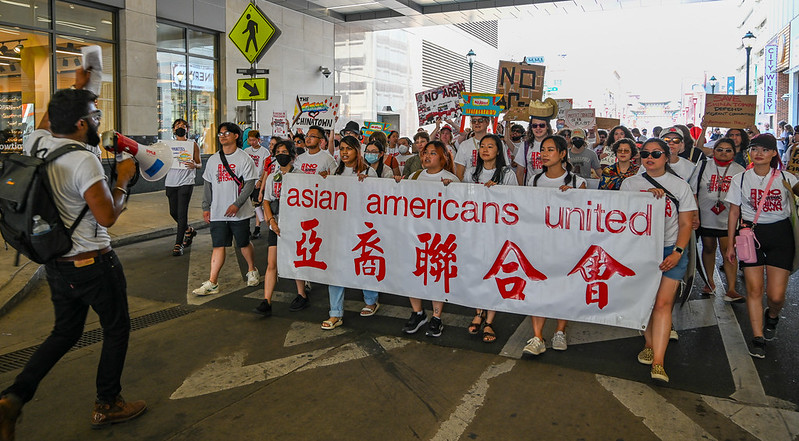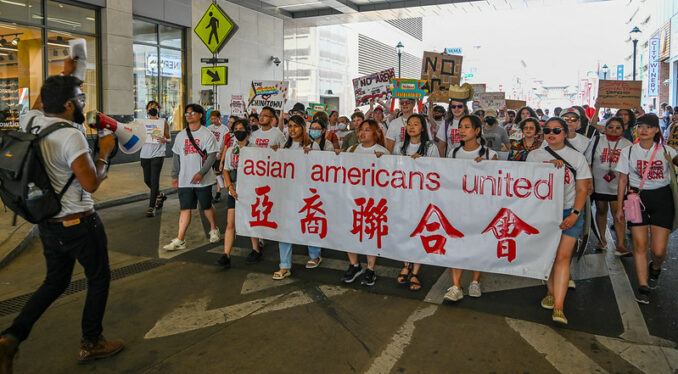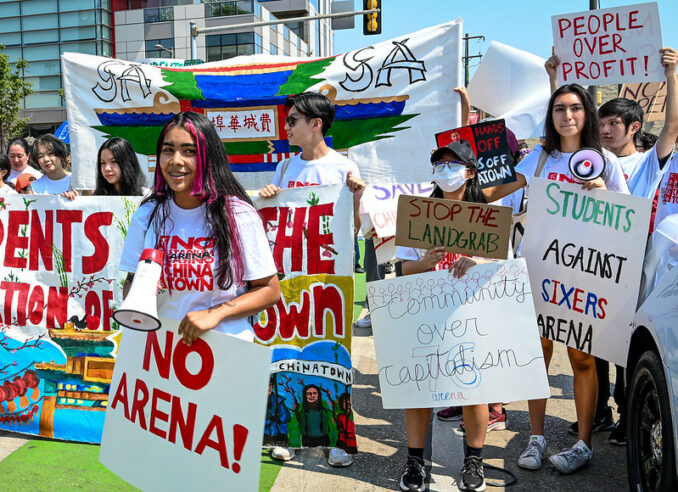

Asian Americans United banner, Philadelphia, June 10, 2023. (Photo: Joe Piette)
Over 3,000 protesters from Chinatown and supporting communities marched through downtown Philadelphia on June 10 with a loud and clear message to the billionaire owners of the 76ers basketball team — “No arena in Chinatown!”


Asian Americans United banner, Philadelphia, June 10, 2023. (Photo: Joe Piette)
The diverse coalition of 20 sponsoring groups included several Chinatown cultural, educational and religious organizations; Latinx immigrants with Juntos; clergy from multinational Power Interfaith; and Black and Brown residents from UC Townhomes, who are struggling against displacement in West Philadelphia.
Contingents in the march included a Chinese women’s group; Students Against Sixers Arena; Asian Americans United; the Asian Pacific American Labor Alliance (APALA), AFL-CIO; Filipino youth with Anakbayan; university students from Temple and Swarthmore; and more. The multigenerational march followed months of organizing to raise awareness that people need unity to stop gentrification.


Students against the arena contingent, Philadelphia, June 10, 2023. (Photo: Joe Piette)
Along the march route, one multinational group of young activists started a chant: “Black, Brown, Asian, white — workers of the world unite!”
Drummers, a traditional Chinese dragon, a large Phoenix puppet, dancers and singers from the community, as well as Black youth drummers and Latinx musicians accompanied the marchers. At the concluding rally, a group of elders and youth sang a song developed over decades of resisting efforts of billionaires to gentrify Chinatown.
The march started at 10th and Vine Streets, on an overpass above the Vine Street Expressway, built in the 1990s despite community opposition. Chinatown was partially destroyed by the expressway’s construction, an “urban renewal project” which eliminated housing and physically divided in half the neighborhood of 3,000 residents.
The energy from the marchers was palpable, especially when demonstrators went under tunnels on both sides of the Fashion District Mall that amplified the sound of their chants and drums. The plans for the proposed arena call for tearing down half of the mall.
Sound of chants is amplified as marchers traverse tunnels, Philadelphia, June 10, 2023. (Photo: Joe Piette)
Many families, seniors and youth call Chinatown home. Plans to build a new $1.3 billion basketball arena adjacent to this community have aroused strong opposition, including from most area businesses.
An empty promise of jobs
Basketball team co-owner and billionaire real estate developer David Adelman claims the project would bring jobs to the area. Similar construction in other cities, including Washington, D.C., have had little benefit or job creation for residents, while destroying their neighborhoods.
Adelman, who joined co-owners Josh Harris and David Blitzer in October 2022, claims that traffic concerns will be minimized if fans use public transportation. It’s difficult to imagine, however, car-friendly basketball fans from the suburbs or from New Jersey getting on SEPTA’s public trains and buses.
The owners have also tried to divide Philadelphia’s Black community from Asian residents of Chinatown with the promise of more jobs for Black workers, but the history of this type of construction project shows that few workers are hired who have not already been employed.
The arena food-concession-stand jobs are minimum-wage jobs. Area restaurants won’t stand a chance competing against the major chain restaurants that would be featured at the arena, plus the arena would be empty 60% of the year.
The march concluded with a rally outside Philadelphia City Hall, where speakers reminded politicians, whose offices are in the building and who work there, that the decision on what is developed in Chinatown belongs to its residents.
The Chinatown residents have a proud history of resisting attempts to destroy their community with major construction projects. In 2000, the Chinatown residents fought efforts to build a baseball stadium there and won. They said “no casino” in 2008 and won. Today the Save Chinatown coalition has the slogan, “Now we’re saying no arena, and we will win.”
“They are coming for our land,” said Debbie Wei, a founding member of Asian Americans United. “They want to take over Chinatown. We’re here to tell them ‘No.’ This is not what the community wants. It’s not what the community needs.”
Anakbayan Philadelphia contingent in Save Chinatown march, June 10, 2023. (Photo: Joe Piette)
Wei concluded her remarks by citing the list of projects, including schools, recreation centers, religious and cultural centers and other projects that would benefit residents of Chinatown. “We’ll keep fighting. We’ll keep showing up,” Wei said, “I think today, we’re gonna show very clearly that this community is united.”
Of note — many of the young leaders of today’s struggle grew up learning from the experience of elders like Wei, who led the fights that stopped the previous attacks on their 150-year-old community.
Special to Workers World The following is a press release issued on April 24, 2025,…
dear Larry Krasner, we heard you sued Elon Musk over his corrupt million election giveaways…
Unions join forces against harassment and deportation of members When 200 immigrant workers – from…
Larry Holmes First Secretary Workers World Party Dear Comrade, Under the assignment of the Central…
Download the PDF Black and white version All out for May Day! Students defend pro-Palestine…
By Jonas, Mutual Aid Scientific Socialism To the workers and free peoples of the world: We…